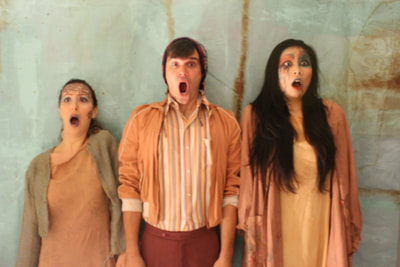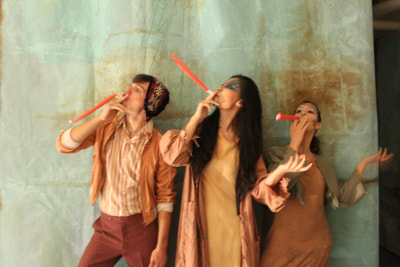Peer Gynt
Independent Project
by Henrik Ibsen
Directed + Designed by Andrew Child
by Henrik Ibsen
Directed + Designed by Andrew Child
Check out the visual inspiration for Peer Gynt here.
Thoughts on directing Peer Gynt...
I did work for a theatre company that audio-described its performances for audience members who were blind. I wanted to know if there was a way to create a piece of theatre that could unite an audience past the point where select members needed to self-identify as exceptions to an assumed rule of the human experience. The idea of a performance for a blind-folded audience that embraced the capabilities of sound took shape and simmered in my mind for years. There is even a draft of a script titled The Isle is Full of Noises: A Sound Play Based on The Tempest saved on my desktop.
But over the past few years, I have interacted with more and more artists who would be entirely barred from attending the show I had in my head. I am thrilled now to present what I hope is the first step on a journey exploring how theatre artists can effectively instigate the accessibility of their own works. Must we, as creators, allow administrative powers to dictate who can and cannot fully experience our creations? Is there a way, from the genesis of our work, we can actively advocate for those the theatre has actively excluded since the Greeks put their spectators on glorified flights of stairs?
I will concede that this production of Peer Gynt does not sit atop the pinnacle of access. This work requires an audience who can not only see and hear, but also navigate their way to the middle floor of Spingold Theater Center. Our limited technical capabilities have rendered room 111 an ADA compliance nightmare we can only hope the powers that be never find out about. The truth of the matter is that accessibility almost always requires time and resources. This project has strained under the limitations of both. However, we still press to ask if the theatre’s current tools for accessibility are the only ways to invite a wider audience to partake in our art. We present Peer Gynt not as a solution, but as a question. What do we miss when we cannot see or there is no intentionally-generated sound? What do we gain? How do we rely on the relationship between visual and aural experiences to synthesize information? To formulate a narrative? How does isolating the visual from the aural invite a more exciting experience?
Peer Gynt is a work that terrifies me. There is no way to read it without somehow feeling it is directly commenting on your own life. As a generally private person, it feels dauntingly like exhibitionism to stage Peer Gynt. An astute audience member can glean, by means of osmosis, elements of an autobiographical nature that may not be intentionally placed. However, in culmination of my time at Brandeis, while sentimental, it feels appropriate to engage with the idea of a journey to find the self. Peer Gynt does not take the hero’s journey, but rather, like Dorothy, returns to the place he was previously avoiding to find both self and home. Like Peer, many of us have felt limited and therefore acted foolishly. Thank you to the Solveigs who wait for our returns.
But over the past few years, I have interacted with more and more artists who would be entirely barred from attending the show I had in my head. I am thrilled now to present what I hope is the first step on a journey exploring how theatre artists can effectively instigate the accessibility of their own works. Must we, as creators, allow administrative powers to dictate who can and cannot fully experience our creations? Is there a way, from the genesis of our work, we can actively advocate for those the theatre has actively excluded since the Greeks put their spectators on glorified flights of stairs?
I will concede that this production of Peer Gynt does not sit atop the pinnacle of access. This work requires an audience who can not only see and hear, but also navigate their way to the middle floor of Spingold Theater Center. Our limited technical capabilities have rendered room 111 an ADA compliance nightmare we can only hope the powers that be never find out about. The truth of the matter is that accessibility almost always requires time and resources. This project has strained under the limitations of both. However, we still press to ask if the theatre’s current tools for accessibility are the only ways to invite a wider audience to partake in our art. We present Peer Gynt not as a solution, but as a question. What do we miss when we cannot see or there is no intentionally-generated sound? What do we gain? How do we rely on the relationship between visual and aural experiences to synthesize information? To formulate a narrative? How does isolating the visual from the aural invite a more exciting experience?
Peer Gynt is a work that terrifies me. There is no way to read it without somehow feeling it is directly commenting on your own life. As a generally private person, it feels dauntingly like exhibitionism to stage Peer Gynt. An astute audience member can glean, by means of osmosis, elements of an autobiographical nature that may not be intentionally placed. However, in culmination of my time at Brandeis, while sentimental, it feels appropriate to engage with the idea of a journey to find the self. Peer Gynt does not take the hero’s journey, but rather, like Dorothy, returns to the place he was previously avoiding to find both self and home. Like Peer, many of us have felt limited and therefore acted foolishly. Thank you to the Solveigs who wait for our returns.






